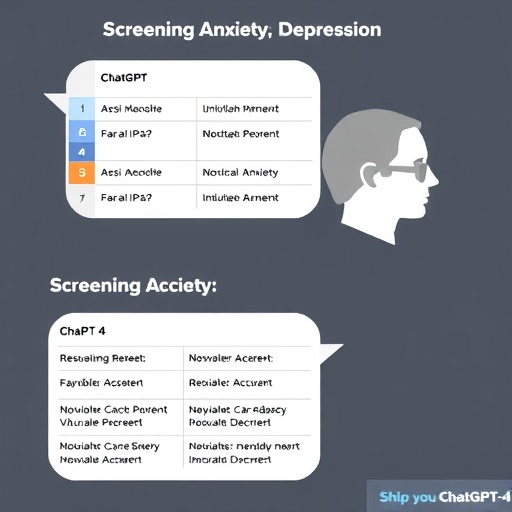In a groundbreaking study that intertwines artificial intelligence with mental health screening, researchers have explored the capabilities of ChatGPT-4 in replicating and potentially enhancing traditional diagnostic tools used for anxiety and depression. This pioneering work, recently published in BMC Psychiatry, evaluates how well ChatGPT-4’s adaptations correspond with established questionnaires, marking a significant stride towards AI-assisted mental health assessments.
Mental health disorders such as anxiety and depression pose substantial challenges worldwide, particularly among college students who often face immense academic and social pressures. Recognizing symptoms early can significantly improve outcomes, but the demand for accessible, efficient screening tools remains unmet in many settings. Traditional questionnaires like the Patient Health Questionnaire-9 (PHQ-9) and the Generalized Anxiety Disorder Scale-7 (GAD-7) have long served as gold standards in clinical and research settings, yet they rely heavily on self-reporting and require administration by trained personnel.
Enter ChatGPT-4, an advanced iteration of large language models developed by OpenAI, capable of understanding and generating human-like text. Harnessing its natural language processing abilities, the study’s investigators tasked ChatGPT-4 with generating structured interview questionnaires that mirror the content and intention of the PHQ-9 and GAD-7. These AI-generated versions, designated as GPT-PHQ-9 and GPT-GAD-7, offer an innovative approach: transforming static questionnaires into dynamic, conversational assessments that could potentially lower barriers to mental health screening.
The research utilized a cohort of 200 college students who were assessed using both the traditional validated questionnaires and the newly designed ChatGPT-4 adaptations. To ensure rigour, the team applied statistical methods including Spearman correlation analysis and intra-class correlation coefficients (ICC) to gauge reliability and consistency between the two sets of measures. The results revealed promising reliability metrics with Cronbach’s alpha values of 0.75 for GPT-PHQ-9 and 0.76 for GPT-GAD-7, suggesting that the AI-generated instruments maintain internal consistency comparable to their established counterparts.
Intraclass correlation coefficients further supported the concordance between the traditional and AI versions, registering 0.80 for the PHQ-9 and 0.70 for the GAD-7. Spearman’s correlation reflected moderate associations, reinforcing that ChatGPT-4’s dynamically generated questionnaires align well with the clinically validated scales. These correlation values signal that although not perfect, the AI-adapted tools capture core symptoms reliably, laying a foundation for their potential application in broader screening contexts.
Beyond correlation, diagnostic accuracy was scrutinized using Receiver Operating Characteristic (ROC) curve analyses, a standard approach to determine optimal cutoff points that balance sensitivity and specificity. For depressive symptom screening, an AI-generated questionnaire cutoff score of 9.5 achieved high sensitivity and specificity, paralleling the original PHQ-9 performance. Similarly, the GPT-GAD-7 demonstrated an optimal cutoff at 6.5 for detecting anxiety symptoms, endorsing its viability as a screening instrument.
To delve deeper into the nuances of agreement, Bland–Altman plots were employed, visually examining differences between AI-generated and validated questionnaire scores. These graphical assessments confirmed acceptable limits of agreement, further substantiating the AI tool’s potential to approximate human-administered assessments without significant bias or deviation.
The implications of this study are profound. By effectively transforming established psychiatric screening tools into AI-driven conversational formats, ChatGPT-4 could democratize access to mental health evaluation. Such tools may reduce the stigma often associated with clinic visits, offer instant preliminary assessments, and triage students for professional care efficiently. Furthermore, AI’s adaptability allows for continual refinement, potentially tailoring questions to individual responses in real-time, enhancing accuracy and user engagement.
Importantly, while this study focused on college students—a demographic exhibiting heightened vulnerability to mood disorders—the methods and findings hold promise across diverse populations. Future research is encouraged to validate the AI-based questionnaires within various age groups, cultural contexts, and clinical settings to confirm their robustness and generalizability.
However, the study is not without limitations. The cross-sectional design provides a snapshot rather than longitudinal insight into symptom changes over time. Additionally, considerations surrounding data privacy, algorithmic transparency, and ethical deployment of AI in mental health contexts warrant careful navigation to ensure safety and equity.
From a technological perspective, the capacity of large language models like ChatGPT-4 to comprehend nuanced human emotion and psychopathology underscores a new frontier in computational psychiatry. AI’s role could evolve from passive questionnaire administration to more interactive, empathetic supports that aid clinicians and empower patients alike.
In summary, this innovative research articulates a compelling vision where artificial intelligence synthesizes clinical expertise with advanced computational linguistics to redefine mental health screening frameworks. The promising concordance between GPT-generated assessments and validated tools heralds a future wherein mental health support becomes more accessible, personalized, and efficient through AI integration.
As mental health disorders rise globally, the necessity for scalable, effective screening mechanisms has never been greater. The demonstrated reliability and diagnostic precision of ChatGPT-4’s adapted questionnaires serve as an encouraging testament to the transformative potential of AI in psychiatry. Further investigations and technological refinements will be critical in harnessing this potential responsibly, ensuring that AI-enhanced mental health evaluations adhere to the highest standards of care and ethical accountability.
This seminal study not only contributes to academic discourse but also lays groundwork for tangible applications that could revolutionize how mental health services are delivered in educational institutions and beyond. The convergence of AI and psychiatry exemplified here invites a future where early detection and intervention become the norm rather than the exception, ultimately advancing public health outcomes on a global scale.
Subject of Research: Evaluating the validity and agreement of AI-adapted screening questionnaires for anxiety and depression compared to validated clinical tools in college students.
Article Title: Evaluating the agreement between ChatGPT-4 and validated questionnaires in screening for anxiety and depression in college students: a cross-sectional study
Article References:
Liu, J., Gu, J., Tong, M. et al. Evaluating the agreement between ChatGPT-4 and validated questionnaires in screening for anxiety and depression in college students: a cross-sectional study. BMC Psychiatry 25, 359 (2025). https://doi.org/10.1186/s12888-025-06798-0
Image Credits: Scienmag.com




